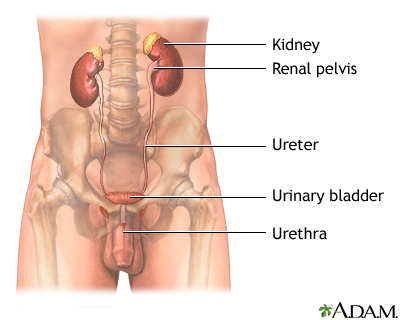
A urinary tract infection, or UTI, is an infection that can happen anywhere along the urinary tract. Urinary tract infections have different names, depending on what part of the urinary tract is infected.
- Bladder -- an infection in the bladder is also called cystitis or a bladder infection
- Kidneys -- an infection of one or both kidneys is called pyelonephritis or a kidney infection
- Ureters -- the tubes that take urine from each kidney to the bladder are only rarely the site of infection
- Urethra -- an infection of the tube that empties urine from the bladder to the outside is called urethritis
UTI Symptoms
The symptoms of a bladder infection include:
- Cloudy or bloody urine, which may have a foul or strong odor
- Low fever (not everyone will have a fever)
- Pain or burning with urination
- Pressure or cramping in the lower abdomen (usually middle) or back
- Strong need to urinate often, even right after the bladder has been emptied
If the infection spreads to your kidneys, symptoms may include:
- Chills and shaking or night sweats
- Fatigue and a general ill feeling
- Fever above 101 degrees Fahrenheit
- Flank (side), back, or groin pain
- Flushed, warm, or reddened skin
- Mental changes or confusion (in the elderly, these symptoms often are the only signs of a UTI)
- Nausea and vomiting
- Severe abdominal pain (sometimes)
Source : nlm.nih.gov
Comments
Post a Comment